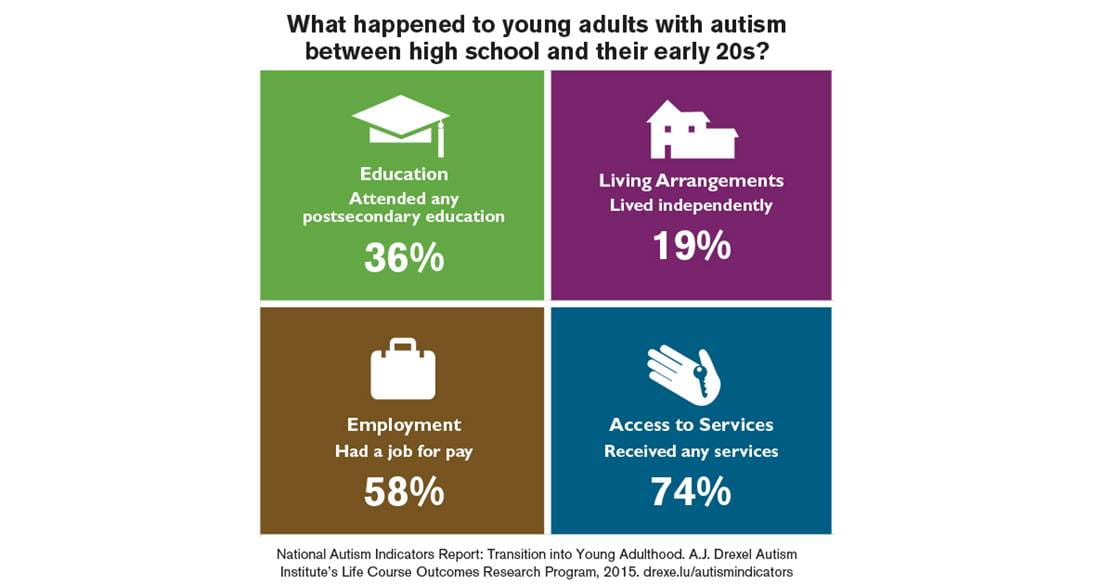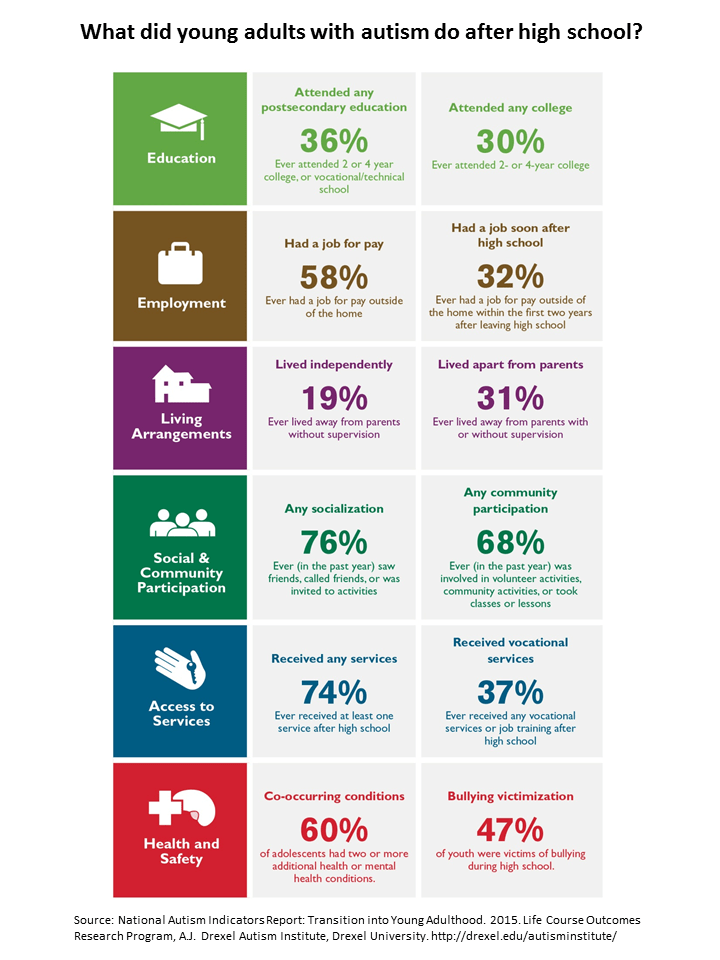Drexel Releases National Indicators Report on Autism & Adolescent Transitions
 By Rachel Ewing
By Rachel Ewing

- Drexel Selects New, World-Class Life Sciences Building at 3201 Cuthbert Street for Medical Research Operations
- Turn Happy Places and Memories into a Happy New Year
- Breakthrough on Gene Therapy for Hereditary Spastic Paraplegia
- Drexel Environmental Collaboratory Releases Cross-Sector Findings on Severe Weather Recovery Challenges

Autism does not end when children reach adulthood—yet most public awareness, public policy and research about autism focus on the needs of children. Families, service providers, community leaders and policymakers still know too little about the experiences and outcomes of young people on the autism spectrum as they enter their adult lives. What are their experiences with transition planning, living arrangements, social participation, employment, postsecondary education, health and mental health, safety and other domains?
Answers to these and other critical questions, addressing life outcomes beyond clinical interventions, are the focus of a report issued today from Drexel University’s A.J. Drexel Autism Institute, from its Life Course Outcomes Research Program. The “National Autism Indicators Report: Transition into Young Adulthood” is a comprehensive report (available free online) that presents new findings about a wide range of experiences and outcomes of youth on the autism spectrum between high school and their early 20s, including new safety and risk indicators for young adults with autism. The report describes the indicators now available and serves as a call to action to fill the remaining large gaps in knowledge.
“When it comes to understanding how well our nation is helping youth affected by autism, our situation is like driving a car through the fog with no dashboard,” said Paul Shattuck, PhD, leader of the Life Course Outcomes Research Program and an associate professor at Drexel. “We know we’re moving, but we do not have many indicators to tell us how fast we are going, whether we’re getting close to our goals, or what kind of mileage we are getting from the resources fueling our trip.”

The report is a collection of indicators that focuses national attention on outcomes which are almost universally lower for those on the autism spectrum compared to their peers with other types of disabilities.
Key findings include:
- Adult Outcomes and Disconnection measures of how life, work and play are related, show that the combined picture is poor for a large proportion of young adults on the spectrum: Over one third (37 percent) of young adults with autism were disconnected during their early 20s, meaning they never got a job or continued education after high school. In comparison, less than eight percent of young adults with other types of disabilities were disconnected.
- The Services Cliff, a dramatic decline in access to services during the transition to adulthood, affects many young adults with autism, including those who are disconnected. Approximately 26 percent of young adults on the autism spectrum, and 28 percent of those unemployed and not in school, received no services – services which could help them become employed, continue their education or live more independently.
- Employment is often the primary transition goal of students with disabilities as they prepare to exit high school. The report indicates 58 percent of young adults on the autism spectrum worked for pay outside the home between high school and their early 20s—a rate far lower than young adults with other types of disabilities. Those who got jobs generally worked part-time for low wages.
- Postsecondary Education measures participation in college or vocational/technical schools, a critical pathway to employment. Only 36 percent of young adults on the autism spectrum attended postsecondary education, including 2-year and 4-year colleges, at some time between high school and their early 20s.
- Social and Community Participation opportunities often result from connections formed from work and continued schooling, so these opportunities may be absent in disconnected youth. Approximately one in four young adults with autism were socially isolated, meaning they never saw or talked with friends and were never invited to social activities within the past year.
- Living Arrangements have a range of outcomes because some, but not all, people on the autism spectrum will eventually live independently as adults with or without some degree of support. One in five young adults on the autism spectrum ever lived independently (away from parents without supervision) between high school and their early 20s.
- Health and Mental Health issues complicate autism-associated transition challenges. Over 60 percent of youth had at least two health or mental health conditions in addition to autism spectrum disorder. The authors found almost no national level data on the health and mental health of young adults with autism.
- Safety and Risk have been the focus of little published research about youth and young adults with autism, although generally people with developmental disabilities are vulnerable to abuse of all kinds. Nearly half of youth on the autism spectrum were victims of bullying during high school. Over one-quarter (27 percent) of adolescents engaged in some type of wandering behavior in which they impulsively left a supervised situation, increasing their risk of becoming lost and going missing.
- Transition Planning, a key process for helping youth build skills and access services as they enter adulthood, was frequently delayed. Just 58 percent of youth had a transition plan by the federally required age.
“This is the most comprehensive report to date describing what we know about young adults with autism as a whole and across the various parts of their lives. Yet, it represents only a fraction of what we need to know. Huge gaps remain,” said Anne M. Roux, MPH, research scientist at the A.J. Drexel Autism Institute in the Life Course Outcomes Research Program and lead author of the report.
“While the picture looks bleak, we found that some of those who have the most significant levels of challenges do go on to find jobs and attend further education,” said Shattuck. “A critical next step is to figure out what facilitates connections to outcomes and what helps people to continue to succeed across their early adult years.”
National-level data included in the report come from the National Longitudinal Transition Study -2 (NLTS2) and the Survey of Pathways to Diagnosis and Services. The report also includes self-reports from a portion of adults with autism who were able to respond to the surveys.
The A.J. Drexel Autism Institute is the first research organization built around a public health science approach to understanding and addressing the challenges of autism spectrum disorders across the lifespan. Its Life Course Outcomes (LCO) Research Program envisions a future where people on the autism spectrum are valued as contributing members of our communities who have roles to play and dreams to pursue. The LCO Research Program is building a base of knowledge about the things other than clinical interventions that promote positive outcomes for people on the autism spectrum and their families and communities. The Indicators Initiative is one of its four major areas of research focus.
The National Autism Indicators Report is available to download online here.
For more information about the National Autism Indicators Report, email LCOinfo@drexel.edu. The A.J. Drexel Autism Institute’s Life Course Outcomes Research Program is on Facebook at https://www.facebook.com/autismlco and Twitter at https://twitter.com/autismLCO. The short link to the report download page is http://drexe.lu/autismindicators.
Drexel News is produced by
University Marketing and Communications.